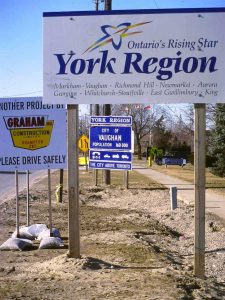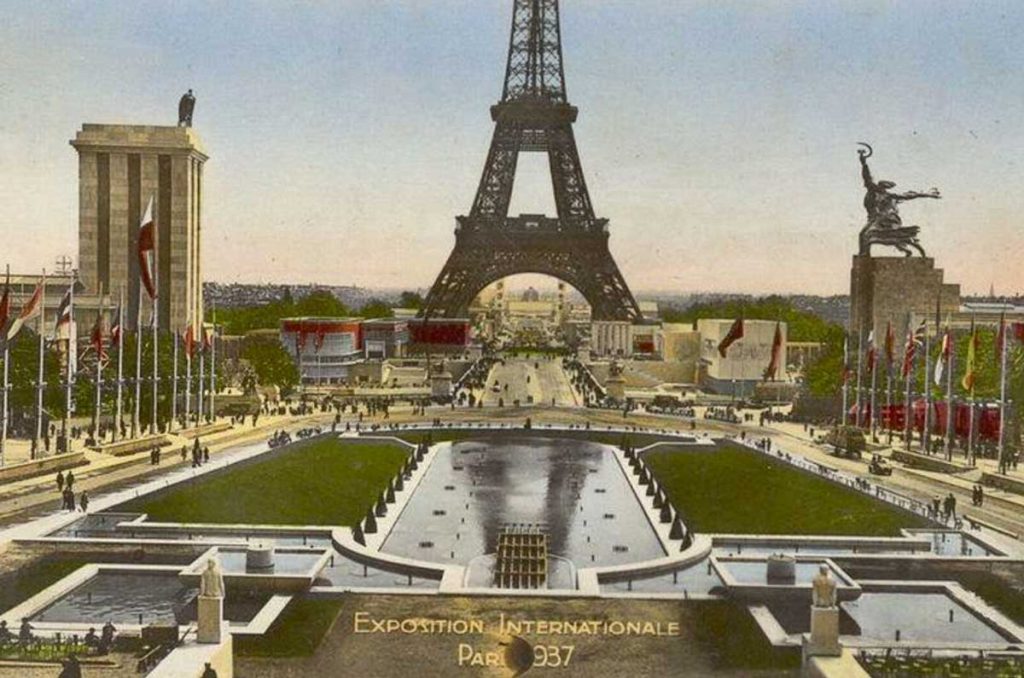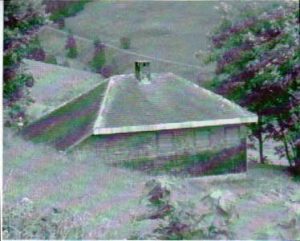
Signs showing three levels of government in Canada – the Province of Ontario, York Region and the City of Vaughan.
Places are everywhere permeated with politics. To live somewhere is unavoidably to be caught up in matters of politics and government, variously at municipal, regional or national scales. The degree to which you are actively involved in these is, of course, a matter of choice. Nevertheless, flags, official signs, town halls and state legislatures, news items on television, and websites with information about everything from garbage collections to opportunities for foreign investment are constant reminders of the presence of governments and politics in everyday places.
In spite of this, the great majority of books and articles about place have little nothing to say about politics. One reason may be that suggested by Alexandra Kogl in her book Strange Places : “Place has appeared in political thought for thousands of years, but typically it has done so in disguise, conceptually conflated with community, the public realm, or the territory of the polity itself.” Another is offered by Jeff Malpas (1999), who has proposed that place, because it resists any simple characterization or definition, actually defines “the very frame within which the political must itself be located.” Place is therefore prior to and yet separate from politics.
These comments skate past the evidence that place does play a very important role in political ideologies and practices. This post, which makes no claims to be a comprehensive review of what has been written on the subject, summarizes what I consider to be the two most important themes in the politics of place. One is the great weakness of place – that ideas about roots, belonging and homelands can all too easily be used as a justification for exclusion, and even extreme political ideologies such as ethnic cleansing that facilitate what I have called a poisoned sense of place (Relph, 1997). The other theme is that no place, no matter how distinctive, is an island. You can easily confirm this by reflecting on where you live. All places are simultaneously distinctive localities because of their history and environment, and interconnected to other other parts of the world by roads, immigration, information, airports, trade, family ties, food imports, ethnic restaurants and so on. Geographer John Agnew (1987) expressed this succinctly in his investigation of neighbouring cities in Tuscany by stating that a politics of place has to acknowledge both the local individuality and the interdependence of places.
Extreme and Poisoned Politics of Place
Totalitarianism and fascism pull place apart in apart in opposite directions, both with brutal, oppressive consequences. In totalitarian regimes individuality and history are suppressed, and places are replaced with placeless sameness. This oppressive placelessness is not discussed in writing about the politics of place though it was a focus of dystopian literature of the 20th century, such as Evgeny Zamyatin’s novel We, written in 1920s Russia, and Aldous Huxley’s Brave New World. Versions were realized in Stalin’s Soviet Union, the Chinese cultural revolution, and Pol Pot’s Cambodia

Politically opposite extremes confronted one another with similarly massive iconography at the International Exposition in Paris in 1937. On the left Nazi Germany; on the right and Stalinist Russia.
At the other extreme are regimes that extol the identity of their place and its supposedly glorious past as superior to all others. Roberto Dainotto (2000), a literary theorist, has argued forcefully that all ideas of place which appeal to roots and belonging offer a misleading cozy communalism that ignores the power struggles, class confrontations and hegemonies of history. Instead they invoke exclusion and the worst forms of nationalism, fascism and regionalism, including ethnic cleansing and genocide. He suggests that the search for valid, rooted places began with philosopher Martin Heidegger as an attempt to confront the twin pincers of Bolshevism and capitalism that he saw confronting Germany in 1920s and 30s and which he thought threatened to uproot Germany’s traditional culture and replace it with the “homelessness” or indifference to Being that infects modernity. Heidegger, much of whose philosophical writing was an attempt to disclose the experience of place, was seduced by the twisted, romantic notions of homeland and heimat promoted by the Nazis, and remained a member of the Nazi party from 1933 until the end of the Second World War.

Heidegger’s cabin in the Black Forest, where he presumably thought about belonging, dwelling and homecoming.
David Gauthier, in Martin Heidegger, Emmanuel Lévinas and the Politics of Dwelling (2011), offers a more modulated assessment of place and fascism. Gauthier suggests that in spite of Heidegger’s association with the Nazis his writing was for the most part apolitical, and that he had a general antipathy to modern politics because he understood it as supporting the technologies that contribute to the sense of being adrift in the world that is homelessness. Heidegger hoped for a “homecoming” or rediscovery of belonging through dwelling in particular places and regions. Lévinas criticizes Heidegger on the grounds that in Nazi Germany this sort of place-based homecoming had been manifestly conducive to exclusion and tyranny. For Lévinas place is about welcoming others to your home, an attitude that requires a continual effort to create ethically responsible political institutions and policies.
Local Autonomy, Globalization, and an Outward Looking Politics of Place
Those who have written about politics and place have explicitly challenged arguments that promote roots and belonging, not least because globalization in its various social and economic forms has infiltrated almost everywhere and this requires a political recognition of broader spatial processes and the interactions between places. Doreen Massey (1994, 2007), Ash Amin (2004) and others refer to this as a relational understanding of places, one that sees cities and even remote communities as routinely involved in global networks of trade and information and otherwise implicated in distant connections. In their view a place a particular place is a more or less distinctive node at an intersection of these networks. Amin maintains that this requires a reading of the politics of place that cuts across geographies at different scales from local, to regional, to national to global. A relational politics of place, he suggests, is topological rather than just territorial; it combines politics of propinquity and of connectivity. The former addresses the everyday negotiations of diversity in cities, including local history and culture; the latter reaches out to other places through, for example, efforts to attract immigrants and foreign investment, and attempts to learn from other places about policies and practices they have used to address their own local problems.

Resistance against a relational politics of place. A sign protesting neo-liberalism (militarism, and repression, and fascism) in the City of Oaxaca in Mexico in 1997
David Harvey, who like Massey and Amin understands place through the lens of political economy, writes in Justice, Nature and the Geography of Difference 1996 (pp.293-5) that place in all its guises is a social construct that involves the constant fixing of capital, partly through local growth and partly by creating new networks between different places. In this view, as in Massey’s, particular places are products of the adaptation to local circumstances of economic and social processes (class differences, economic investment and so on) that are international and perhaps universal in scope. Successful places are those invested with sufficient permanence to become centers of institutionalized power, while those that become economically obsolete have to be demolished, or perhaps preserved as heritage sites. From this perspective, while local identity and individual commitment to a place are not unimportant, they are held to be subservient to widely shared political processes and the injustices they perpetrate.
Although a relational politics of place may favour shared and international concerns about class and exploitation over ones of local history and identity, it nevertheless does avoid the dualistic thinking that sets what is regarded as local against globalization. For instance, historian Arif Dirlik (1998) cites Bruno Latour’s argument that a railroad is simultaneously local at all points and global because it connects widely separated places, and then asks: “What if the global were local, or place-based, just as the local were global?” The answer is that in many aspects the global is indeed local, for instance, the origins of goods we buy, the news we watch, and changes in the weather because of global warming. At the same time, the local is global because almost everywhere contributes to global warming, or produces goods and information that are used in distant places. In short, a relational politics of place involves a hybrid understanding that begins to answer, in Dirlik’s words, “the need for new ways to reorganize political space.”
Doreen Massey, whose writing in the 1990s about a global sense of place was a foundation for the idea of a relational politics of place, has summarized this hybrid approach to political space in two innovative phrases. In her book World City (2007) Chapter 10 is titled “A Politics of Place beyond Place,” and in that chapter she elaborates the important ideas of “an outward looking politics of place.”
The Democratic Potential of Places
In her 2008 book Strange Places Alexandra Kogl, a political scientist, offers a slightly different interpretation of this hybrid idea of place politics. She acknowledges the fusion and tension of global and local processes in capitalist, neo-liberal political economies, but in contrast to Harvey and Massey her emphasis is on the local side of the balance between these processes. Specifically she argues for the democratic potential of places in the context of their interdependencies because places are not merely passive vessels but are themselves powerful because of the meaning that is invested in them (p.2). Furthermore she claims (p.142) that: “the political activity that emerges around the shared circumstances of everyday life in the places where people live can be an effective way of generating democratic forms of power among some of the least privileged persons in liberal regimes.” In other words, it is the relative autonomy of a place, rather than its interdependence, that is politically most important. She recognizes, however, that there is a limit to this because it is unrealistic to expect that “the power relations of the larger political economy,” which touch ground in everyday places, can be democratized by persons acting in small groups in those places. As a way to counter these larger power relations she draws on the ideas of Deleuze and Guattari in their philosophical work A Thousand Plateaus, and suggests that democracy must be rhizomatic, which is to say that it too must globalize by growing out of “multiplicities of roots sunk in countless places.”

This partial screen capture from City Mayors, an online forum for mayors of cities around the world, gives an indication of rhizomatic processes that are growing out of countless places around the world and which are unrelated to national politics.
Practical and Pragmatic Politics of Place
The ideas of Kogl, Massey, Harvey, Amin, and for that matter Heidegger and Dainotto, are largely theoretical. Yet according to Arif Dirlik (2001) the politics of place is a practical politics because it addresses issues that have tangible outcomes in the environments where people live and work even as the character of these issues is constantly shifting with the currents of global flows.
I agree with Dirlik. I have written (Relph, 2008) about the need for a pragmatic sense of place that will be needed to meet the challenges of the 21st century, which include climate change and extreme weather events, mass migration and cultural assimilation, pandemics, terrorism and ragged wars, and a resurgence of religious and cultural intolerance. The consequences of these are so geographically varied and locally specific that national or even regional strategies are bound to have limited success unless they are adapted to the particularities of places, and that can only happen by giving additional responsibility to those places. Federal politicians in the rarified atmosphere of their debating chambers may dither about the causes and consequences of climate change. Regardless of this, local politicians in particular places have to take immediate practical measures to reduce emissions of greenhouse gases, deal with rising sea levels, and establish preparations for cool shelters in the event of heat waves. They also have to find ways to assimilate immigrants, attract foreign investments that can lead to local jobs, and regulate Air BnB rentals that are exacerbating shortages of affordable housing. And they have to do this while respecting local heritage and the diverse opinions of the citizens who elect them.

This sign in the city hall of the suburban city of Mississauga, adjacent to Toronto, illustrates the combination of inward looking and outward looking attitudes that have become essential in the practical politics of place.
My suspicion is that while national governments will continue to be important because they provide financial resources and policy directions, there are indications that they have begun to lose their authority because they have become too remote from everyday life and because they have been bypassed by electronic communications which move directly from place to place. In the practical politics of place responsibility will gradually shift from a national to a local level because it is at the scale of cities and towns that a balance has to be found between local identity and openness to the world.Of course policies and decisions will be contested, sometimes the particularities of place will win out, sometimes interdependence, but overall and in the long run a practical politics of place must continue to look simultaneously inward to the qualities of specific places, and look outward to what they shares with other places and the people in those places.
A Final Caution: A Poisoned Politics of Place
While I believe that a practical politics of place is well worth hoping for, and there are many indications of a shift towards this, there are also indications of a shift towards a poisoned politics of place. A recent article by Nancy Isenberg and Andrew Burstein (2017)on the current political situation in the United States is titled “Cosmopolitanism vs Provincialism: How the Politics of Place hurts America.” Cosmopolitanism is about looking outward and to the future, shared human values, and acceptance of differences. Provincialism, which is the politics of place Isenbery and Burstein suggest is hurting America, sets boundaries to a place, whether region or nation, and looks mostly inward, usually to a glorified past. It is the ideology that this place is somehow special and needs to be protected from outside influences. It is the beginning of a potential drift to a society based on exlusionary conservatism. In various degrees it informs Donald Trump’s exceptionalist view of America, Brexit, the expulsion of the Rohingya from Myanmar, nationalist politics in Hungary, and alt-right nationalist movements around the world. These suggest a resurgence of poisoned and exclusionary politics of place and they need to be resisted by a positive and practical politics of place that welcomes others, embraces difference, acknowledges interdependencies, and looks both inward and outward.
A Bibliographic Note
A search of the University of Toronto online library catalogue for books and articles with titles about the politics of place revealed books on zoning, apartheid, urban India, post-war Germany, native Hawai’i, issues of race in African American communities, regional planning, Ottoman Istanbul, development in the sunbelt, management of grizzly bears, The Death of Jesus and the Politics of Place in the Gospel of John, Girlhood and The Politics of Place, and a British journal on the Politics of Place intended for postgraduates. Apparently the “politics of place” serves as convenient shorthand to describe more or less local case studies where there was perhaps, but not necessarily, some sort of political disagreement. I may have missed something, but as far as I could gather most of these, including the journal, have little or no substantial discussion about politics, place or the politics of place.
Agnew, John 1987 Place and Politics: The Geographical Mediation of State and Society (Boston: Allen and Unwin)
Amin, Ash 2004 “Regions Unbound: Towards a new politics of place” Geografiska Annaler, 86B, 1, 33-44
Dainotto, Roberto 2000 Place in literature: regions, cultures, communities (Ithaca, NY: Cornell University Press)
Dirlik, A. 1998 “Globalism and the politics of place” Development 7-13
Dirlik, A. 2001 “Placed-based imagination: Globalism and the politics of place” Places and Politics in an Age of Globalization, eds Prazniak, R. and Dirlik, A. (New York: Rowman and Littlefield).
Gauthier, David 2011 Martin Heidegger, Emanuel Levinas, and the Politics of Dwelling, (Lanham MD: Lexington Books)
Harvey, David 1996 Justice, Nature and the Geography of Difference (Oxford: Blackwell)
Isenberg, Nancy and Burstein, Andrew 2017 “Cosmopolitanism vs Provincialism: How the Politics of Place hurts America” The Hedgehog Review, Vol 12, 2
Kogl, Alexandra 2008 Strange places: the political potentials and perils of everyday spaces (Lanham, MD : Lexington Books)
Malpas, Jeff 2000 Place and Experience: a philosophical topography (Cambridge University Press)
Massey Doreen 1994 Space, Place and Gender (University of Minnesota Press)
Massey Doreen 2007 World City, (Cambridge: Polity Press)
Relph, Edward 1997 “Sense of Place” in Ten Geographical Ideas that Have Changed the World, ed Susan Hanson, (Rutgers University Press)
Relph, Edward 2008 “A Pragmatic Sense of Place” in Making Sense of Place: Exploring concepts and expressions of place through different senses and lenses eds F. Vanclay, M. Higgins, and A. Blackshaw (Canberra: National Museum of Australia)